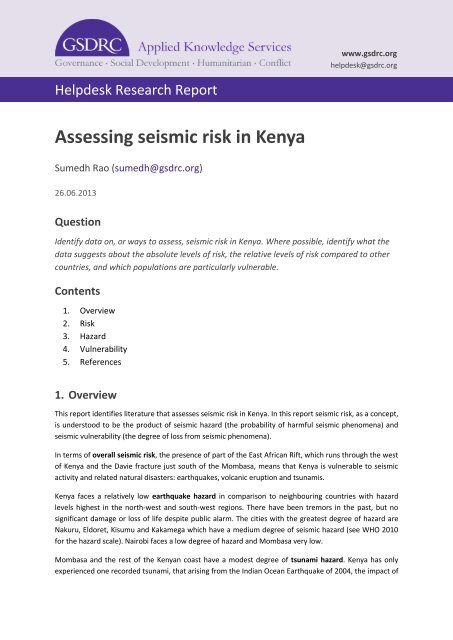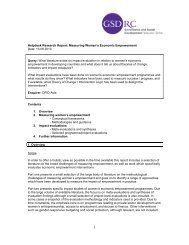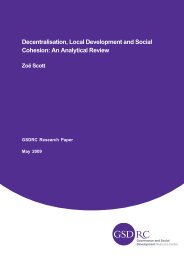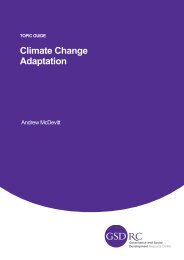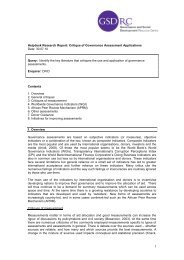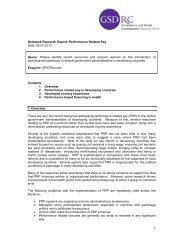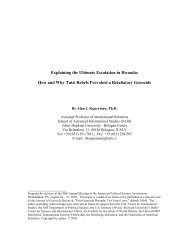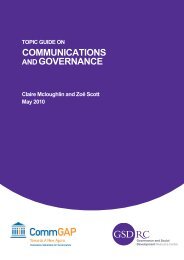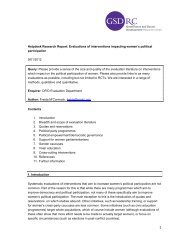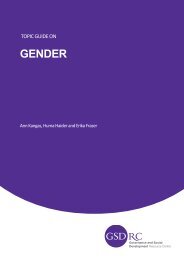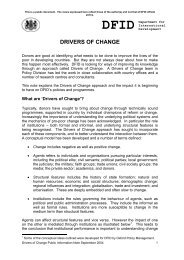Assessing seismic risk in Kenya - GSDRC
Assessing seismic risk in Kenya - GSDRC
Assessing seismic risk in Kenya - GSDRC
Create successful ePaper yourself
Turn your PDF publications into a flip-book with our unique Google optimized e-Paper software.
www.gsdrc.orghelpdesk@gsdrc.orgHelpdesk Research Report<strong>Assess<strong>in</strong>g</strong> <strong>seismic</strong> <strong>risk</strong> <strong>in</strong> <strong>Kenya</strong>Sumedh Rao (sumedh@gsdrc.org)26.06.2013QuestionIdentify data on, or ways to assess, <strong>seismic</strong> <strong>risk</strong> <strong>in</strong> <strong>Kenya</strong>. Where possible, identify what thedata suggests about the absolute levels of <strong>risk</strong>, the relative levels of <strong>risk</strong> compared to othercountries, and which populations are particularly vulnerable.Contents1. Overview2. Risk3. Hazard4. Vulnerability5. References1. OverviewThis report identifies literature that assesses <strong>seismic</strong> <strong>risk</strong> <strong>in</strong> <strong>Kenya</strong>. In this report <strong>seismic</strong> <strong>risk</strong>, as a concept,is understood to be the product of <strong>seismic</strong> hazard (the probability of harmful <strong>seismic</strong> phenomena) and<strong>seismic</strong> vulnerability (the degree of loss from <strong>seismic</strong> phenomena).In terms of overall <strong>seismic</strong> <strong>risk</strong>, the presence of part of the East African Rift, which runs through the westof <strong>Kenya</strong> and the Davie fracture just south of the Mombasa, means that <strong>Kenya</strong> is vulnerable to <strong>seismic</strong>activity and related natural disasters: earthquakes, volcanic eruption and tsunamis.<strong>Kenya</strong> faces a relatively low earthquake hazard <strong>in</strong> comparison to neighbour<strong>in</strong>g countries with hazardlevels highest <strong>in</strong> the north-west and south-west regions. There have been tremors <strong>in</strong> the past, but nosignificant damage or loss of life despite public alarm. The cities with the greatest degree of hazard areNakuru, Eldoret, Kisumu and Kakamega which have a medium degree of <strong>seismic</strong> hazard (see WHO 2010for the hazard scale). Nairobi faces a low degree of hazard and Mombasa very low.Mombasa and the rest of the <strong>Kenya</strong>n coast have a modest degree of tsunami hazard. <strong>Kenya</strong> has onlyexperienced one recorded tsunami, that aris<strong>in</strong>g from the Indian Ocean Earthquake of 2004, the impact of
which was relatively m<strong>in</strong>or. Accord<strong>in</strong>g to assessments, the coast is vulnerable to 2 metre high waves andwater reach<strong>in</strong>g 500 metres <strong>in</strong>land. It has not been possible to estimate volcanic hazard <strong>in</strong> this helpdeskreport.In terms of overall vulnerability, an earthquake <strong>in</strong> <strong>Kenya</strong> is likely to result <strong>in</strong> more economic loss than <strong>in</strong>neighbour<strong>in</strong>g Somalia, but at similar levels to other neighbour<strong>in</strong>g countries. In this helpdesk report it hasnot been possible to obta<strong>in</strong> sub-national data or f<strong>in</strong>ite estimates of loss result<strong>in</strong>g from <strong>seismic</strong> activity.Most key vulnerability analyses do not cite <strong>seismic</strong> activity and subsequent natural hazards as asignificant concern <strong>in</strong> <strong>Kenya</strong>. These vulnerability analyses do not estimate the vulnerability of differentpopulations to <strong>seismic</strong>-related hazards but do identify populations vulnerable to hazardous factors andhumanitarian <strong>risk</strong> <strong>in</strong> general. It may be that these vulnerable groups – primarily refugees, <strong>in</strong>ternallydisplaced persons (IDPs), and those work<strong>in</strong>g <strong>in</strong> agriculture – are more vulnerable to <strong>seismic</strong> hazards.Those vulnerable to conflict; flood<strong>in</strong>g; and water, sanitation and hygiene-related diseases may also bemore vulnerable to <strong>seismic</strong> <strong>risk</strong>s.2. Risk<strong>Kenya</strong> is traversed by the <strong>seismic</strong>ally active Great African Rift Valley, one of the most earthquake proneareas of the world (MSSP n.d.). Consequently the area of the Great Rift Valley with<strong>in</strong> <strong>Kenya</strong> and parts ofthe Nyanza bas<strong>in</strong> are prone to earthquake and volcanic activity. However, casualties result<strong>in</strong>g fromearthquakes have been low (MSSP n.d.). In July 2007, for example there were earth tremors thatemanated from Mount Oldo<strong>in</strong>yo Lengai <strong>in</strong> Northern Tanzania but were felt <strong>in</strong> Nairobi, Mombassa, andNakuru caus<strong>in</strong>g public scare (MSSP and NDOC 2009).Based on data from the Global Assessment Report on Disaster Risk Reduction 2013, figure 1 illustratesthe level of earthquake <strong>risk</strong> <strong>in</strong> <strong>Kenya</strong> and surround<strong>in</strong>g countries. Figure 2 focuses closer on <strong>Kenya</strong>. Inthese maps the green represents the degree of vulnerability to earthquake loss with darker greenmean<strong>in</strong>g more significant loss. The yellow to red colour represents the degree of earthquake hazard withred be<strong>in</strong>g the most significant and yellow be<strong>in</strong>g less significant.2 <strong>GSDRC</strong> Helpdesk Research Report
<strong>Assess<strong>in</strong>g</strong> <strong>seismic</strong> <strong>risk</strong> <strong>in</strong> <strong>Kenya</strong>Figure 1. Earthquake <strong>risk</strong> for <strong>Kenya</strong> and surround<strong>in</strong>g countries (Global Assessment Report on DisasterRisk Reduction 2013)Source: Risk Data Viewer http://<strong>risk</strong>.preventionweb.netFigure 2. Earthquake <strong>risk</strong> for <strong>Kenya</strong> (Global Assessment Report on Disaster Risk Reduction 2013)Source: Risk Data Viewer http://<strong>risk</strong>.preventionweb.net3
3. HazardThe East African Rift System (EARS) is a 50km to 60km wide zone of volcanoes and faults that extendnorth to south <strong>in</strong> Eastern Africa for more than 3000km (1864 miles), from Ethiopia <strong>in</strong> the north to theZambezi <strong>in</strong> the south. <strong>Kenya</strong> is located with<strong>in</strong> the East African Rift System with the Rift runn<strong>in</strong>g throughthe western part of <strong>Kenya</strong> and act<strong>in</strong>g as the ma<strong>in</strong> source of <strong>seismic</strong>ity <strong>in</strong> <strong>Kenya</strong> (Ngunjiri 2007). Thissection gives an overview of hazard <strong>in</strong> <strong>Kenya</strong> from earthquakes, tsunamis, and volcanoes.3.1 Earthquake hazardFigures 3 and 4 demonstrate how earthquake hazard and <strong>in</strong>tensity is most prom<strong>in</strong>ent along the rift thatruns from the north-west to the south-west of <strong>Kenya</strong> with particular hazard/<strong>in</strong>tensity around the northwestand south-west borders. Figure 4 suggests that there are areas <strong>in</strong> <strong>Kenya</strong> where earthquake activitymay be destructive although most of western <strong>Kenya</strong> faces strong and <strong>in</strong> some cases very strongearthquake <strong>in</strong>tensity.Figure 3. Earthquake hazard for <strong>Kenya</strong> and neighbour<strong>in</strong>g countries (Global Assessment Report onDisaster Risk Reduction 2013)Source: Risk Data Viewer http://<strong>risk</strong>.preventionweb.net4 <strong>GSDRC</strong> Helpdesk Research Report
<strong>Assess<strong>in</strong>g</strong> <strong>seismic</strong> <strong>risk</strong> <strong>in</strong> <strong>Kenya</strong>Figure 4. Earthquake hazard for <strong>Kenya</strong> and surround<strong>in</strong>g countries (OCHA)Source: OCHA 2007Figure 5 shows the major cities <strong>in</strong> relation to <strong>seismic</strong> hazard. Of note is that the most populous citiesNairobi and Mombasa are <strong>in</strong> areas with low and very low <strong>seismic</strong> hazard. Nakuru, Eldoret and Kisumu,with populations of over 200,000, are based <strong>in</strong> an area of medium <strong>seismic</strong> hazard.5
Figure 5. Seismic Distribution Map (WHO)Source: WHO 2010Although Mombasa is located away from the East African ridge it is located near to a <strong>seismic</strong>ally activearea of the Davie fracture, a tectonic plate fracture zone, which runs from <strong>Kenya</strong> due south towardsMadagascar and Mombasa's population is to some extent at <strong>risk</strong> from this (Keima expert comments).3.2 Tsunami hazardTsunami hazard assessment has shown that the <strong>Kenya</strong>n coast is vulnerable to tsunamis that aregenerated <strong>in</strong> Indian or Pacific oceans (Amollo 2007). Simulations have shown that the region canexperience tsunami wave heights of up to 2m high and <strong>in</strong>undation extent is greatest <strong>in</strong> the unprotectedareas reach<strong>in</strong>g about 500m <strong>in</strong>land. However, <strong>Kenya</strong> has only recorded one tsunami <strong>in</strong> its history, that ofthe 2004 Indian Ocean tsunami.<strong>Kenya</strong> has a 600km long coastl<strong>in</strong>e, with Mombasa as the pr<strong>in</strong>cipal <strong>Kenya</strong>n seaport and a number ofsettled communities and establishments based on the coast. The coastal region is low-ly<strong>in</strong>g and ischaracterized by a fossil reef that lies a few meters above sea level. <strong>Kenya</strong>n mangrove forests, which haveserved as a defence aga<strong>in</strong>st strong waves, have been over-exploited, and <strong>in</strong> some cases completelydestroyed with the areas converted to other uses such as for salt ponds. This has left vast areas barelead<strong>in</strong>g to coastal erosion and lack of protection aga<strong>in</strong>st storm surges and tidal waves (MSSP n.d.).The 2004 Indian Ocean tsunami reached <strong>Kenya</strong> and is the first recorded tsunami <strong>in</strong> <strong>Kenya</strong> (Ngunjiri 2007).It came at low tide and was consequently less damag<strong>in</strong>g than to other countries, especially those closerto the epicentre of the earthquake. One person was reported dead and there was property destruction ofvary<strong>in</strong>g magnitudes along the entire coastl<strong>in</strong>e, especially to the fish<strong>in</strong>g <strong>in</strong>dustry. Mal<strong>in</strong>di Bay and Lamu6 <strong>GSDRC</strong> Helpdesk Research Report
<strong>Assess<strong>in</strong>g</strong> <strong>seismic</strong> <strong>risk</strong> <strong>in</strong> <strong>Kenya</strong>were most affected by destruction of fish<strong>in</strong>g gear, boats and lost man-hours, which was due to theseareas be<strong>in</strong>g wide, shallow and open (MSSP n.d.).3.3 Volcanic hazardThe volcanoes with<strong>in</strong> <strong>Kenya</strong> are ext<strong>in</strong>ct and dormant runn<strong>in</strong>g from North to South and East to West(MSSP 2009). In this study it was not possible to identify data that illustrates volcanic hazard.4. VulnerabilityThere is limited literature that documents specific vulnerability to earthquakes <strong>in</strong> <strong>Kenya</strong>. Figure 6 belowprovides an overview of probable maximum economic loss from an earthquake, which allows forcomparison between neighbour<strong>in</strong>g countries. However sub-national data did not seem to be available.Figure 6. Earthquake Probable Maximum Loss (Global Assessment Report on Disaster Risk Reduction2013)Source: Risk Data Viewer http://<strong>risk</strong>.preventionweb.netA number of key reports that exam<strong>in</strong>ed vulnerability <strong>in</strong> <strong>Kenya</strong> along various dimensions (e.g. Oxfam 2009,Parry et al. 2012, Christiansen & Subbarao 2004) do not cite earthquakes, volcanic activity or tsunamis asa major concern although they are often listed under natural disasters that <strong>Kenya</strong>n’s may face.The most recent Emergency Humanitarian Response Plan for <strong>Kenya</strong> 2013 (Parry et al. 2012) notes thatcommunities rema<strong>in</strong> vulnerable to disasters due to factors, such as poverty, livelihood <strong>in</strong>security, andsettlement <strong>in</strong> areas prone to seasonal flood<strong>in</strong>g or with poor <strong>in</strong>frastructure and services, such as <strong>in</strong>formalurban settlements. These groups are vulnerable to hazards such as droughts, floods, landslides, epidemic7
outbreaks and climatic change. The report makes no specific note of <strong>seismic</strong> activity and subsequenthazards such as earthquakes and tsunami.Based on population growth, high poverty rates (57% of <strong>Kenya</strong>ns live below the poverty l<strong>in</strong>e),unemployment, the high prevalence of HIV/AIDS and an economy largely dependent on ra<strong>in</strong>-fedagriculture the report argues that a significant proportion of the population is highly vulnerable todisasters, and any small, predispos<strong>in</strong>g factor may result <strong>in</strong> emergencies of high proportion, oftenculm<strong>in</strong>at<strong>in</strong>g <strong>in</strong> national disasters (Parry et al. 2012).Parry et al. (2012) highlights the follow<strong>in</strong>g areas as highly vulnerable disaster-affected districts: TurkanaNE, Turkana South, Turkana NW, Turkana Central, Mandera West, Mandera Central, ManderaEast/North, Wajir West/North, Wajir East, Marsabit, Wajir South, Garbatulla.The report does not specify that these districts and groups are particularly vulnerable to <strong>seismic</strong> <strong>risk</strong>, butrather humanitarian <strong>risk</strong> <strong>in</strong> general.Specific groups listed as vulnerable <strong>in</strong>clude: refugees and <strong>in</strong>ternally displaced persons (IDPs) (especiallyrefugee/IDP women and children); and agro-pastoralists, pastoralists and small-scale farmers(especially those <strong>in</strong> Arid and Semi-arid Lands).Those prone to other humanitarian <strong>risk</strong>s may well be more vulnerable to <strong>seismic</strong> <strong>risk</strong>s than the largerpopulation. The <strong>Kenya</strong>n water, sanitation and hygiene (WASH) sector coord<strong>in</strong>ation mechanism(WESCOORD) coord<strong>in</strong>ates support to WASH measures <strong>in</strong> times of drought emergencies and support forpreparedness, <strong>risk</strong> reduction and recovery measures after drought. The mechanism has identified anumber of priority counties not<strong>in</strong>g their conflict and flood<strong>in</strong>g <strong>risk</strong>s, as well as the likelihood of WASHrelateddisease outbreaks (see table 1). These priority counties may well be more vulnerable to other<strong>risk</strong>s such as <strong>seismic</strong> <strong>risk</strong>.Table 1. Water, sanitation and hygiene sector coord<strong>in</strong>ation mechanism (WESCOORD) locationsWESCOORD Priority ConflictLikelihood of WASH-related diseaseFlood<strong>in</strong>g RisksCountiesRisksoutbreaksGarissa High High HighIsiolo High Low LowKilifi High Moderate ModerateKisumu High High HighKwale High Moderate LowLaikipia High Low LowMandera High Low HighMarsabit High Low ModerateMigori High High HighNarok High Low ModerateTana River High High HighWajir High Moderate HighWest Pokot High Low LowBar<strong>in</strong>go Moderate Low LowBusia Moderate High HighKajiado Moderate Low LowKitui Moderate Low HighMakueni Moderate Low Moderate8 <strong>GSDRC</strong> Helpdesk Research Report
<strong>Assess<strong>in</strong>g</strong> <strong>seismic</strong> <strong>risk</strong> <strong>in</strong> <strong>Kenya</strong>WESCOORD Priority ConflictLikelihood of WASH-related diseaseFlood<strong>in</strong>g RisksCountiesRisksoutbreaksSamburu Moderate Low LowTaita Taveta Moderate Low LowKitui Moderate Low LowTharaka Moderate Low LowTurkana Moderate Low ModerateMachakos Low Low HighSource: Parry et al. 20135. ReferencesAmollo, J. (2007). East Africa Rift System, Seismic Activity, Ground Deformation and Tsunami HazardAssessment <strong>in</strong> <strong>Kenya</strong> Coast. <strong>Kenya</strong> Meteorological Department. http://www.seis.nagoyau.ac.jp/kimata/jica/actionplan09/Joseph.pdfChristiansen, L. and Subbarao, K. (2004). Toward an Understand<strong>in</strong>g of Household Vulnerability <strong>in</strong> Rural<strong>Kenya</strong>. World Bank Policy Research Work<strong>in</strong>g Paper 3326. Wash<strong>in</strong>gton D.C.: World Bank.http://elibrary.worldbank.org/docserver/download/3326.pdf?expires=1371650308&id=id&accname=guest&checksum=BD61A2E09C0272D3F5D7625536F154D1MSSP . (n.d.). Natural Hazard Fact Sheets for <strong>Kenya</strong> and the African Region. Government of <strong>Kenya</strong>M<strong>in</strong>istry of State for Special Programmes (MSSP).MSSP . (2009). National Policy for Disaster Management <strong>in</strong> <strong>Kenya</strong>. Government of <strong>Kenya</strong> M<strong>in</strong>istry of Statefor Special Programmes (MSSP). http://www.ifrc.org/docs/idrl/1058EN.pdfMSSP and NDOC. (2009). National Disaster Response Plan 2009. Republic of <strong>Kenya</strong> M<strong>in</strong>istry of State forSpecial Programmes (MSSP) and M<strong>in</strong>istry of Prov<strong>in</strong>cial Adm<strong>in</strong>istration and Internal Security - NationalDisaster Operation Centre (NDOC). http://www.ifrc.org/docs/idrl/857EN.pdfNgunjiri, C. (2007). Tsunami and Seismic Activities <strong>in</strong> <strong>Kenya</strong>. <strong>Kenya</strong> Meteorological Department.http://www.seis.nagoya-u.ac.jp/kimata/jica/ngunjiri.pdfOCHA. (2007). Earthquake Risk <strong>in</strong> Africa: Modified Mercalli Scale. United Nations Office for theCoord<strong>in</strong>ation of Humanitarian affairs (OCHA) Regional Office for Central and East Africa.http://www.preventionweb.net/files/7483_OCHAROCEAEarthquakesv2071219.pdfOxfam. (2009). Urban Poverty and Vulnerability In <strong>Kenya</strong>. Background analysis for the preparation of anOxfam GB Urban Programme focused on Nairobi. Oxford: Oxfam GB.http://www.ir<strong>in</strong>news.org/pdf/urban_poverty_and_vulnerability_<strong>in</strong>_kenya.pdfParry, J., Echeverria, D., Dekens, J. and Maitima, J. (2012). Climate Risks, Vulnerability and Governance <strong>in</strong><strong>Kenya</strong>: A review. UNDP. http://www.iisd.org/pdf/2013/climate_<strong>risk</strong>s_kenya.pdf9
WHO. (2010). <strong>Kenya</strong>: Seismic Hazard Distribution Map. WHO. http://www.whoeatlas.org/africa/images/map/kenya/ken-<strong>seismic</strong>.pdfKey websites• Global Assessment Report on Disaster Risk Reduction 2013 Data Platform:http://www.preventionweb.net/english/hyogo/gar/2013/en/home/data-platform.htmlExpert contributorsRuss Welti, Incorporated Research Institutions for Seismology (IRIS)Ben Parker, UN OCHA <strong>Kenya</strong>Michelle Grobbelaar, Pennsylvania State UniversityVunganai Midzi, Council for Geoscience, ZambiaGabriella Waaijman, UN OCHA Eastern AfricaEdward Kiema, Government of <strong>Kenya</strong> National Disaster Operations CentreAndrew Nyblade, Pennsylvania State UniversitySanjay Rane, UN OCHA Eastern AfricaSuggested citationRao, S. (2013). <strong>Assess<strong>in</strong>g</strong> <strong>seismic</strong> <strong>risk</strong> <strong>in</strong> <strong>Kenya</strong>. <strong>GSDRC</strong> Helpdesk Research Report 964. Birm<strong>in</strong>gham, UK:<strong>GSDRC</strong>, University of Birm<strong>in</strong>gham. http://www.gsdrc.org/go/display&type=Helpdesk&id=964About this reportThis report is based on three days of desk-based research. It was prepared for the UK Government’sDepartment for International Development, © DFID Crown Copyright 2013. This report is licensed underthe Open Government Licence (www.nationalarchives.gov.uk/doc/open-government-licence). The viewsexpressed <strong>in</strong> this report are those of the author, and do not necessarily reflect the op<strong>in</strong>ions of <strong>GSDRC</strong>, itspartner agencies or DFID.The <strong>GSDRC</strong> Research Helpdesk provides rapid syntheses of key literature and of expert th<strong>in</strong>k<strong>in</strong>g <strong>in</strong>response to specific questions on governance, social development, humanitarian and conflict issues. Itsconcise reports draw on a selection of the best recent literature available and on <strong>in</strong>put from <strong>in</strong>ternationalexperts. Each <strong>GSDRC</strong> Helpdesk Research Report is peer-reviewed by a member of the <strong>GSDRC</strong> team.Search over 300 reports at www.gsdrc.org/go/research-helpdesk. Contact: helpdesk@gsdrc.org.10 <strong>GSDRC</strong> Helpdesk Research Report


